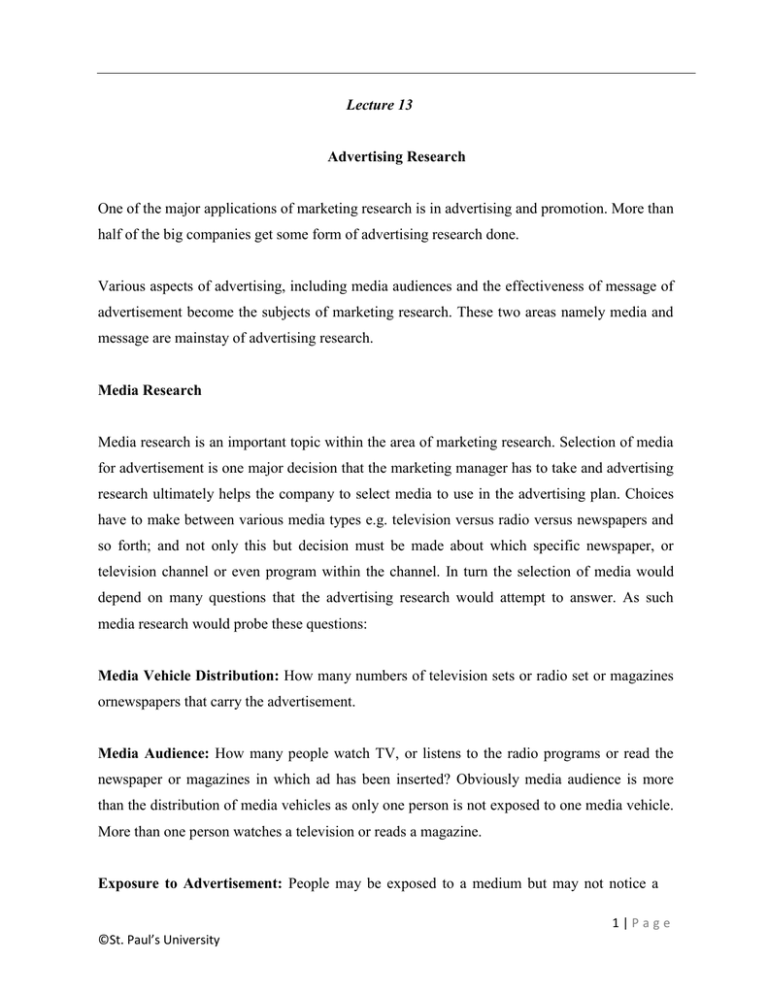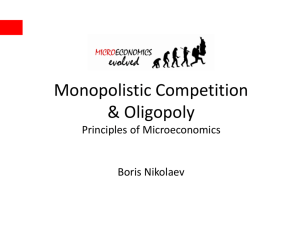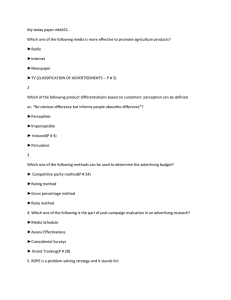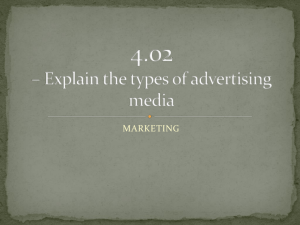Lecture 13 Advertising Research One of the major applications of
advertisement

Lecture 13 Advertising Research One of the major applications of marketing research is in advertising and promotion. More than half of the big companies get some form of advertising research done. Various aspects of advertising, including media audiences and the effectiveness of message of advertisement become the subjects of marketing research. These two areas namely media and message are mainstay of advertising research. Media Research Media research is an important topic within the area of marketing research. Selection of media for advertisement is one major decision that the marketing manager has to take and advertising research ultimately helps the company to select media to use in the advertising plan. Choices have to make between various media types e.g. television versus radio versus newspapers and so forth; and not only this but decision must be made about which specific newspaper, or television channel or even program within the channel. In turn the selection of media would depend on many questions that the advertising research would attempt to answer. As such media research would probe these questions: Media Vehicle Distribution: How many numbers of television sets or radio set or magazines ornewspapers that carry the advertisement. Media Audience: How many people watch TV, or listens to the radio programs or read the newspaper or magazines in which ad has been inserted? Obviously media audience is more than the distribution of media vehicles as only one person is not exposed to one media vehicle. More than one person watches a television or reads a magazine. Exposure to Advertisement: People may be exposed to a medium but may not notice a 1|Page ©St. Paul’s University specific advertisement. Marketing research tries to find out how many people were actually exposed and noticed the advertisement in the media. This number is definitely less than media audience. Advertising Perception: Who, among those who noticed the advertisement, correctly perceived and comprehended the message of the advertisement in question. Sales Response: How many of the persons who were exposed to, noticed and comprehended thead properly, purchased the product in response to the ad. Media Vehicle Distribution Data on some media vehicle distribution are the most readily available from different sources and are not disputed as to their accuracy. Advertisement research uses of these sources frequently; For example Audit Bureau of Circulation (ABC) for newspapers Newspapers and magazines have their own reports. Data about the sales of radio and television sets from the markets. Government agencies surveys about television users. In fact for the broadcast media the measurement of vehicle distribution is much less important as compared to the media audience. Media Audiences The media audience is the number of people actually exposed to the vehicle at least once. Newspapers Readers 2|Page ©St. Paul’s University A newspaper reader is one who claims to have read at least apart of the newspaper in question on a given day. Newspapers themselves sometimes collect readers’ data and the advertisers rely on these data. Televisions Viewers In advertising research, the television viewer ship can be found out by the following methods. Diary Meters Personal Interview Recall In the diary method household viewers are requested by the researcher to record the name of the shows that they watched and mail the diary back to the researcher. The researcher can break down the audience estimates by age, sex, and geographical area from diaries. Audi meter This device is connected electronically to a computer and records when the television is tuned to, if anything was being watched. To avoid self-consciousness, the meter is placed out of view. But it would not indicate the number of people watching a given television set. The audimeter provides an objective measure of televisions viewer activity with no burdensome recordkeeping People meter This is the remedy of the audimeter as to its disadvantage of not indicating the number of people watching the television. People meter allows each member of the family to “log on” and “log off” his or her television viewing time. 3|Page ©St. Paul’s University Coincident telephone recalls method In method a sample of households is telephoned and asked what show is being watched at that time, if any, and also asked to identify the sponsor or product being advertised. Personal interview recall method This method involves interviewing a sample of respondents at homes shortly after the program of interest, most probably the prime time of shows on the television. Radio Audience No formal or syndicated sources are available, and the advertising researcher may rely on information collected by the media itself. Copy Testing The term “copy testing” is used to refer to test the effectiveness all aspects i.e. color, graphics, pictures, action, and so on, of ads. It involves exposing an audience to the advertisement and observing their response A lot of time and effort is spent by the advertisers on copy testing. Copy testing is done at different stages of its development: as a written concept, a set of drawings, an animated version, or a finished advertisement. It may be tested before or after running on the media. These are called Pretests and Posttests. Final version test is ideal as this is what people will be reacting. Ad Testing Procedures Consumer Jury Physiological Methods 4|Page ©St. Paul’s University Inquiry Tests On-the-air Tests Trailer Tests Sales Tests Consumer Jury In the consumer jury procedure, 50 to 100 consumers from the target audience are interviewed either individually or in small groups. Physiological Methods Some devices are used by the researcher to record the different physiological movements of the viewers and some inferences are drawn to be used in research. Such devices measure the physiological arousal that is normally uncontrollable by the respondent. Skin resistance, heart beat, facial expressions, muscle movement, and voice pitch are analyzed. Some of these devices are described as under. Eye camera: This camera tracks the movement of the eye as it watches an ad. This determine which section/s caught and hold attention and layout of the ad can accord be modified. In print ad it can be found out where the eye focused more time in each second. An analysis can determine what the reader saw, what he or she “returned to” for reexamination, what point was “fixed on” etc. Galvanic skin response (GSR): It measures response to skin by attaching electrodes from are cording device to respondents, when exposed to ads. Tachistoscope is another physiologically related testing device which measures the rate at which an ad conveys information or recognition. 5|Page ©St. Paul’s University Brain-wave analysis: In this analysis the audience is exposed to the advertisement and attention, interest, or emotional reaction to the advertisement can be assessed through wave analysis. The higher the wave amplitude, the more the brain activity is at that point in the advertisement. Brain wave analysis take place in a laboratory setting Inquiry Tests Inquiry tests measure the effectiveness of an ad the on the basis of consumer inquiries that result directly from the ad placed mostly in newspapers or magazines. It provides a direct measure of response with no interview, reducing costs and artificial reactions due to the interviewing process. On-the-Air Tests It involve about interviewing more than 100 respondents who may be contacted by telephone in any of big cities and who claim that they watched a particular television show the night before. They are asked what they remember about the specific ad. What were the sale points in the ad and whether they had any favorable attitude in towards the ad or not. This method is mostly used in television copy testing although does have some critics. Trailer Tests This method is mostly used in the advanced countries like USA. The respondents are chosen from the shopping malls and are taken to a trailer near the mall or even a room in the mall itself. There they are shown several ads with or without surrounding programming, and different questions are asked about the ads including the recall test. Sales Tests 6|Page ©St. Paul’s University In standard advertising tracking, the respondents with the target market profile are interviewed, personally or by telephone, to measure their levels of awareness, attitudes about the ad and the brand, and recent purchases after watching being exposed to the ad. Criteria Criteria of a good advertisement message are: Advertisement recognition Logically, recognition is a necessary condition for effective advertising. If the advertisement cannot pass this minimal test it probably will not be effective Recall of its contents How does it persuade? Impact on purchase behavior i.e. purchase Focus group in advertising Research Focus-group research is widely used in the development of an advertising campaign. Focus groups are mainly used to generate ideas for advertisements and to test reactions to rough executions. Opinions about the advertisement concepts and actual advertisements are sought. Audience impression within the group about what the ad was what ideas we presented, interest 7|Page ©St. Paul’s University in the ideas, and so on. The goal is to detect potent misperceptions as well. Sample Questions in Ad Research Do you remember seeing this ad on TV? Yes No Not sure-I may have What did you see in it? How much interested are you in what this ad is trying to show you? Very interested to some extent not interested How does it make you feel about the product? It’s a good product It’s Ok It’s bad Not sure Please check whether this commercial was Appealing Clever Confusing Convincing Dull Effective Interesting Irritating 8|Page ©St. Paul’s University International Marketing Research Need for International Marketing Research As we know that the international environment is getting more complex day by day and management of many domestic firms lacks familiarity with the foreign markets, it becomes all the more important to undertake research prior to making international marketing decisions and making marketing strategy. This is equally important for decisions relating to initial market entry, product positioning, marketing mix or subsequent expansion decisions. Research will save us from costly mistakes in marketing and loss of valuable opportunities in international markets. Complexity of International Marketing Research Although the marketing research follows the same steps at the international level that the domestic marketing research has, yet the international marketing research is more complex than the market research in the domestic setting. For the sake of revision, let us list the six steps followed in the marketing research process. Understanding the management dilemma Defining research problem and developing research objectives 9|Page ©St. Paul’s University Formulating researching design Collecting data/Fieldwork Analyzing data Writing research report and oral presentation Complexity of International Marketing Marketing on global scales poses problems that are inherently more complex than those encountered in a firm’s domestic market. Operations take place on a much broader scale and scope, often involving a range of different types of activities and management systems including licensing, strategic alliances and joint ventures. International marketing entails operation in a variety of diverse environmental contexts. These range from the mature industrialized markets of Europe, the US and Japan, the unstable but blossoming markets of Latin America, the politically uncertain markets of the Middle East or Russia, and the volatile markets of South East Asia to the emerging African markets. International markets are also characterized by rapid rates of change in the technological, economic, social and political forces that shape their development. Change is rapid and all pervasive, but as well as unpredictable, altering the nature of opportunities and threats in international markets. 10 | P a g e ©St. Paul’s University Research aids in assessing where the best opportunities lie, where and how to enter new markets Diversity of International Environment Diversity occurs particularly in relation to consumer tastes, preferences and behavior, and to a lesser extent, business-to-business markets. The banking system, the structure of distribution adds a further level of complexity to strategy development and implementation. This, in turn, is further compounded by government regulation of business operations, product formulation and packaging, advertising, promotion, pricing as well as trade barriers such as tariffs, import quotas, etc Level of literacy also varies from country to country. While levels of literacy in industrialize countries are typically 99%, it is important to remember that is far from the case in other countries. Information Needs Which markets and target segments will be entered? Which mode of entry and operation should be adopted for specific target markets? What should be the timing for entry How marketing resources must be allocated between different levels of marketing management product/product line level, customer level and market segment/ country market level) 11 | P a g e ©St. Paul’s University How to establish a control system to monitor performance in the target market Information Needs Information needs vary depending on the firm’s experience and degree of involvement in international markets. In the initial phase of entry into international markets, information is needed to assess opportunities and risks in different countries. Issues in International Marketing Research Complexity of Research Design and Difficulties in Establishing Comparability and Equivalence are two predominant issues in international marketing research. The relevant respondent may differ from county to country. European countries, children play an important role in decisions related to the purchase of chocolate or cereals, in other countries which are less child oriented, the mother may be the relevant decision maker. Equally, the role of women is enhancing in financial and insurance decisions. In Arab society, this is rarely the case. Secondary data such as data on motor vehicle registrations may not provide equivalent data between many countries Survey Methods d. Telephone Interviewing e. In-Home Personal Interviews 12 | P a g e ©St. Paul’s University f. Mall Intercept g. Mail Questionnaires h. Electronic Surveys Telephone Interviewing and CATI Telephone interviewing is the dominant mode of questionnaire administration. Telephone (land line) penetration is still not complete in rural areas. In developing countries, only a few households have telephones. Telephone incidence is low in Africa. India is a predominantly rural society where the penetration of telephones is less than 10% of households in the villages. With the decline of costs for international telephone calls, multi country studies can be conducted from a single location. This greatly reduces the time and costs. Cell phone penetration is high Computer- assisted telephone interviewing (CATI) facilities are well developed in the United States and Canada and in some European countries, such as Germany. Mall Intercept In North America, many marketing research organizations have permanent facilities in malls, equipped with interviewing rooms, kitchens, observation areas, and other devices. 13 | P a g e ©St. Paul’s University Mailed Questionnaires Because of low cost, mail interviews continue to be used in most developed countries where literacy is high and the postal system is well developed. In Africa, Asia, and South America, however, the use of mail surveys and mail panels is low because of illiteracy and the large proportion of the population living in rural areas. Electronic Surveys In the United States and Canada, the use of e-mail and the internet is growing by leaps and bounds. Use of these methods for conducting survey is growing not only with business and institutional respondents, but also with households. Questionnaire Translation The questions may have to be translated for administration in different cultures. Direct translation, in which a bilingual translator translates the questionnaire directly from a base language to the respondent’s language, is frequently used Procedures such as back translation and parallel translation have been suggested to avoid these errors. In back translation, the questionnaire is translated from the base language by a bilingual speaker whose native language is the language into which the questionnaire is being translated. This version is then retranslated back into the original language. 14 | P a g e ©St. Paul’s University Translation errors can then be identified. 1. An alternative procedure is parallel translation. A committee of translators translate the questionnaire simultaneously and the translations are compared to decide on the final version 15 | P a g e ©St. Paul’s University Variable Importance Indicators Economic Measure of Economic Wealth, GNP, GNP per capita, Macro level Indicator of Population, Inflation, Market Potential, etc. Unemployment Rate, Interest Rates, etc. Political Measure of Political Stability Type of Govt, Expert ratings of and Political Risk, Govt’s political stability, Attitude towards business, etc. Legal Socio-Cultural Measure of legal risk, Import-Export laws, Tariffs, protectionism, marketing mix Non-tariff barriers, taxes, strategies, etc. copyright laws, etc Measure of High/Low Religion, language, literacy, Context Cultures, Attitude of values, work ethics, role of people, Differences in family, gender roles lifestyles 16 | P a g e ©St. Paul’s University Infrastructural Measure of technological Energy Costs, Extent of advancement, available media computerization, No. of and their relative influence Telephones, Fax Machines, Presence of Mass media, etc. Personnel International research needs a real commitment in terms of personnel resources, such as sampling experts, telephone interviewing experts, etc. and executives with appropriate skills International Marketing Research in Practice There are many major research agencies with multinational operations that provide the benefit of coordinating the project from the home country and assuring the clients of comparability. These agencies also ensure that they have local staff in all of these countries that are familiar with the local culture and traditions and will be in a position to provide better insight about the market. Quotations from two or three international research organizations are obtained. 17 | P a g e ©St. Paul’s University Price is not necessarily the deciding factor. A cheaper quote may mean less rigorous procedures. Recap of the Course Now when you have completed the course, you should be able to do the following tasks: Understand the management dilemma and the decision making situation confronting the marketing manager. Discuss and finalize the research problem. Write the marketing research objectives. Review the related literature and develop research questions and or research hypotheses, if any. Prepare a research design. Determine sample size and select the sample using an appropriate sampling method. Develop the data collection instrument appropriate for your research project Collect data and monitor the field work. Analyze data using appropriate statistical techniques. 18 | P a g e ©St. Paul’s University Write a professional research report and give oral presentation if required by the management/client 19 | P a g e ©St. Paul’s University







